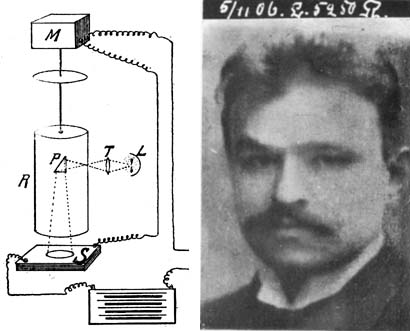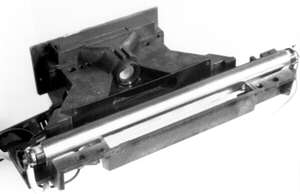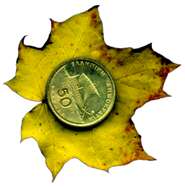The active development of digital
technologies has taken place for the last decade. The majority of printing
houses has changed over only optical methods of preparation of photos
for printing to electronic methods. All these changes have entered a new
word "scanner" into a lexicon of many photographers.
However from all computer devices used by the photographer
scanner is the oldest invention. The systems for scanning image are an
integral part of such devices as a telephoto, telefax, television camera
and they exist for already more than hundred years.
In 1855 the Italian physicist Kazelli has invented the instrument
to transfer image called "pantetelegraph". In this instrument
the needle scanned the image drawn by current-conducting ink. With the
invention of a photocell the telephoto in which the thin light beam moved
on a surface of the photo supported on a drum was made. Light reflects
from the surface of image and gets on the cathode of a photocell causing
an emission current proportional to reflectivity.

In the beginning of the century the German physicist Korn
made the telephoto which doesn't differ from modern drum-type scanners.
(In the figure on the right you can see the circuit of Korn's telegraph
and the portrait of the inventor scanned and transmitted on the distance
more than 1000 km on November 6, 1906). Mechanical scanning of image on
two coordinates takes place in it and each dot is separately lit. Light
passing through it is received by one selenium photodetector and therefore
there is no error connected with unidentity of pick-off. It is the oldest
and the most qualitative but also the most expensive way. It has no basic
limiting on number of dots the image will be composed of. However scanners
of this type demand fixing the image on a drum and therefore do not suit
scanning not bending glass plates.
The development of semiconducting technologies has allowed
to unite some photodetectors in one bar and to do with relocating only
on one coordinate. It has lead to the birth of tablet, rolled, projection
and hand-held scanners. Their optical circuit is absolutely identical
and can be represented as an objective focusing the line of image on the
photodetectors bar. The difference is in the way of relocating a photo,
photodetectors bar and an objective. An objective and a bar of photocells
are usually hard connected and transfered about the photo. Resolution
of similar devices is limited by a number of pick-off in the bar and if
the width of a photo is less than a working surface of the scanner, only
part of photocells is used. In some projection scanners and studio digital
cameras there is relocating bar of photodetectors about the image formed
by moveless objective. Projection scanners allow to focus the object on
all width of the pick-off bar and thus without dependence from the size
of the image to receive the greatest possible resolution.

In the extreme case the mechanical relocating of a photodetector
and light source is absent and there is an electronic scanning of the
whole image. The television cameras and a majority of digital cameras
can be reffered to similar devices. The devices at price up to $1000 usually
have a matrix keeping no more than a million pick-off. There are also
hybrid devices in which the matrix makes microrelocatings thus first all
even points and then all uneven ones are read out.
Colour scanners don't differ from half-tone and image input
is made through colour filters in three doses when at each passage before
a photodetector the blue, green or red filter is installed or have three
pick-off before which the appropriate filters are posed.
What scanner to select is defined by what you are going
to use it for.
For the photographer a construction of the scanner is not
so important as its characteristics which are defined by resolution capability
(number of dots per unit of image square), number of shades which can
be represented numerically (24, 30, 36 bits on a dot depending on the
used analog-to-digital converter) and the range of densities depending
on a dynamic range of the system illuminator-photodetector. It is necessary
to note that the variation of intensity on three orders can be represented
by 16 shades and therefore it is possible to make the scanner which has
only 4 bits for a dot and the intensity is three.
If a scanner for you is auxiliaries in daily work of a photographer
and it is used for creation of photoarchive and check review of negatives
in real colours then the device for scanning transparent and opaque stuffs
about a card suits you by size. Cost of similar equipment with permission
of 400 dots per inch is today less than $200.
It is necessary to mark that the hand-held scanners allow
to solve the majority of problems connected with digitisation and to scan
the image on transparent basic by some resourcefulness and availability
of blueprinting table.
The tablet scanners are the most universal. They can be
used not only for scanning photos but also together with the printer for
copying documents or together with the appropriate programs for recognition
of the text and input it in ASCII format in the computer. Today optical
resolution of scanners cost about $300 are 600 dots per inch. The majority
of them can be completed by console for scanning transparent stuffs.
To evaluate real possibilities of equipment it is necessary
to remember that at polygraph printing and printing on the printer halftones
are made by variation of width line or dots the raster consists of. The
printing quality is defined by number of raster lines per inch (lpi).
For determination of required resolution in dots per inch at scanning
you should clarify what index lpi the printer has and multiply it by 1,5.
At printing newspapers the parameter lpi is 85, for laser and colour ink-jet
printers this parameter is varied from 56 up to 133. At high-quality printing
the number of lines per inch is usually 133 thus you can without loss
of quality print out a photo by size 10x6 cm in a magazine from scanned
on the tablet scanner 35 mm frame. If you have possibility to make a print
by size about all working surface of the scanner, you can print in a printing
house your photo of width 24 cm on a page with the side 70 cm. It is necessary
to mark that the posters are usually typed with the raster in 35 lines
per inch and therefore your photo can be rendered on a four-meter panel
poster. For the photographer the operation with prints has also the advantage
that magnifying an exposition it is possible to have normal prints even
from very dense negatives while the dynamic range of scanners is usually
much less. The exception is drum-type scanners in which photo-electronic
multiplier is used and the brightness of a source can vary. However scanning
on them is the same skill as printing of photos.
The scanners for films 35 mm are largely designed for the
reporters and allow them to get and pass stuff to the editorial office
rather fast and not spending time on printing. The devices with permission
in 2000 dots per inch cost about one thousand dollars. If you have the
necessity to input slides of the different sizes or their fragments into
the computer, then probably the best decision for you will be the digital
camera.
However the scanners interfere and radically change not
only procedure of the photographer operation with snapshots but also become
the separate instrument of creativity.
The circle has become isolated. On a new turn of a spiral
we have returned to phonogram in its electronic creation. We can create
rather expressive compositions just by setting some subjects on the glass
of the tablet scanner. The depth of the sharp image for scanners is insignificant
but nevertheless it is not zero therefore we receive an original view
from the glass underground. And this method unlike phonograms allows to
make not only abstract - shadow composition but also to receive quite
realistic snapshots of flat subjects - coins, sections of stones, leaves...
Write a comment below. No registration needed!




